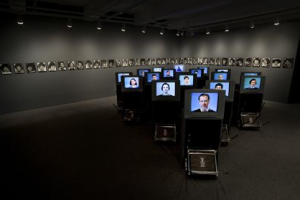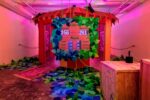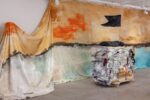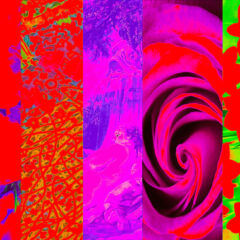You begin with “Permutations.”
You stare into the eyes of a woman; a black screen; a white screen. You strain to see strands of hair dance along the back of her head; a white screen; a black screen. You watch in anticipation as the woman stands before you, her eyes closed; a white screen.
Eyes open.
Eyes closed.
Black screen.
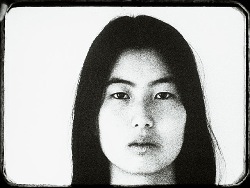
After 10 minutes of engaging with Theresa Hak Kyung Cha’s 1976 film, you turn around to gaze into “Visual Text: Finger Poem” (1968-1973), studying artist Valie Export’s hands as she silently communicates an interpretation of Heideggerian thought, leaving you searching her fingers for some universalized symbolism amid the video’s un-translated German text.
For 11 minutes and 48 seconds you are immersed in a nexus of sensorial impression – captivated by silence, gestures, and sight.
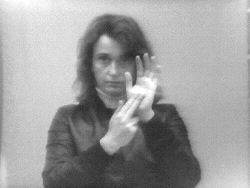
Changing Scenes: Points of View in Contemporary Media Art is the best exhibition currently on view in Philadelphia. The Fabric Workshop and Museum, with guest curator, John G. Hanhardt, deliver an extraordinary showing of artists and works that take point-of-view as concept and explore its variances through film and media art. The artists are described as using “the moving image both to destabilize the authority of the camera and to acknowledge its power to communicate.”
Indeed, spanning the 1970s to the present, Changing Scenes showcases pioneer artists and contemporary favorites representing various conceptual foundations, such as performance-to-camera work and structuralism. Although all the works are well known and acclaimed by the art world, they are presented here in an original context, so as to speak with new voices despite having already occupied myriad spaces.
With the pieces brought together, the exhibit becomes part art history lesson and part philosophical inquiry, with the construction of self, for both artist and viewer, permeating the museum’s floors and creating thought-provoking experiences that are both sensory and reflective.
Adrian Piper explores race and the body
Adrian Piper’s foundational 1999 installation, “Out of the Corner,” takes over the first floor gallery. Accurately described as “a powerful epistemological reflection on the social construction of racial identity within Western society,” Piper’s work specifically explores the identity and consequential construction of the American black woman. Filmed seated behind a desk, Piper speaks directly to the viewer, her eyes never wavering from her intended audience.
Rather than remaining invisible from the viewer’s experience, the artist’s voice and body traverses and grabs hold of the viewer’s gaze, creating a work that is unabashedly confrontational and brilliantly candid.
With the room’s walls lined with sixty-four black and white portraits of black women from Ebony magazine, and sixteen video monitors playing tapes of white men and women of various Western ethnicities, the viewer becomes inserted into an state of self-examination and consideration of other with Piper steadily reminding you that “it” has everything to do with you.
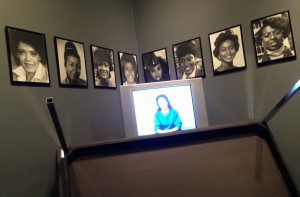
Nam June Paik and Charlotte Moorman examines cultural hegemony with video, music, and found sound
The New Temporary Contemporary screening room presents a selection of six single-channel videotapes from artists including Alexander Kluge, Jason Simon, Ayoka Chenzira, Sadie Benning, Tony Cokes, and Donald Trammel. The senior representatives and highlight were pioneering filmmaker Nam June Paik, and musician/performance artist Charlotte Moorman. Their 1977 performance/documentary collage, “Guadalcanal Requiem,” explores the site of the battle of Guadalcanal in the Solomon Islands and its devastating history in World War II. The sounds from Moorman’s cello, local tongue, US veteran’s stories, historical footage of exploding bombs, and crashing waves are woven into a narrative of cultural diminution and hegemonic ruthlessness in Paik’s signature cacophonous and destabilizing manner of electronic manipulation.
With Moorman as the central face, the placement of the self is marked in the narrative – that essential question of “How am I implicated in this?” manifesting as film progresses.
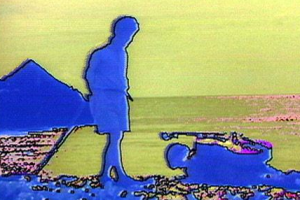

Pepón Osorio delves into issues of existential ennui
The other half of the platform contains a lone stretcher in an outdoor environment lightly sprinkled with richly minimal possessions. A monitor shows a looped video of a woman feeding herself from an empty silver spoon, while a sculptural gold heart placed under a glass case sits on the manicured lawn. Seemingly tranquil and serene, emptiness pervades the scene.
Osorio invites viewers to sit on a couch wrapped in a tacky eagle printed blanket to experience the two contrasting environments and clear dichotomies of wealth. Minimalism vs. mayhem becomes wrapped in questions of loneliness, livelihood, health and responsibility, with material possessions and their juxtaposing textures acting as the driving impetus for reflection. With each glance more is discovered, underscoring “Drowned in a Glass of Water”’s magnificence.

Javier Téllez creates sensorially rich and engaged work
The final experience comes from Javier Téllez’s 2007 film “Letter on the Blind, For the Use of Those Who See,” on the Eighth Floor Gallery. Recreating the Indian parable “The Blind Men and the Elephant,” Téllez filmed six blind people’s experience of interacting with and touching an elephant. Shot in black and white at the disused McCarren Park swimming pool in Brooklyn, the film is sensorially brilliant and texturally remarkable – the concrete pool seen against the elephant’s body, a man’s fur-lined coat blowing against the elephant’s spotted ears, the participants’ careful touch against the roughness of the animal’s skin.
As viewers, our sight becomes juxtaposed with the blind participants lack of the same, while their touch becomes our envy as film’s reality keeps us at distance. Truly stunning, “Letter on the Blind” succeeds in capturing a compassionate narrative as each participant puts to words his or her recollections of touch, while viewers simultaneously reflect on the ability to experience these images.

Changing Scenes has that rare ability to transport its viewers into a space of complete engagement, reflection, and inquiry. Time becomes nonexistent. Each angle is considered. And looped videos could just keep going. After you leave the space it will continue to stay with you, as reflections on language, identity, touch, and sight carry you from place to place. That central question of point-of-view and construction of self is magnified and broadened; while never fully answered, it is brought into ever more crisp and nuanced focus. Changing Scenes is an exhibit all should plan to return to more than once. The $3 admission fee could be charged per floor and you would not think twice about it. The works – and their curation – are that good.
Changing Scenes: Points of View in Contemporary Media Art is on view through Summer 2013.


